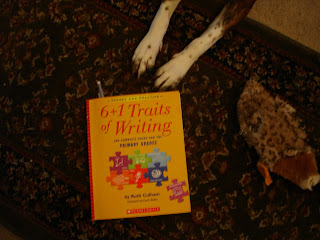
I remember something Lucy Calkins wrote in her landmark writing text, The Art of Teaching Writing. Referring to her son Miles, who is now in his mid-thirties, she tells a story of his focus as a young writer. Miles apparently made a list of things one should pack for a hike. His list of essentials included a "notebuk."
I remember laughing at the absurdity of such an idea. I couldn't picture an 8-year old wanting to bring along a notebook while hiking. The purpose, of course, was the recording of any seed ideas that came up along the way. I say "of course," because now I look upon the inclusion of such a notebook through the eyes of a teacher, writer, mother, and hiker. A notebook serves a useful purpose because not everybody can recall with clarity those little moments that provide fodder for the writers' journal.
I tell my own students that the process of becoming a writer means thinking like a writer, reading like a writer, and living what Katie Wood Ray calls "The Writerly Life." Seed ideas, or small moments, can be quickly recorded and then filed away for future attention. Viewing the world through the lens of a writer means living thoughtfully and taking a moment to notice those small moments and record them for exploration that may lead to a decent piece of writing.
I think it also means living life thoughtfully, with empathy and appreciation. Living it means writing it and making meaning, turning it into something else. As a teacher, it means modeling it. Explicit instruction of the writers' craft is good, but showing a young writer how it works, how that seed idea transforms, and what the finished product may LOOK like - is powerful.
My mind goes off on writerly 'riffs' quite frequently. Seed ideas abound. Pointing this out to young writers will begin the process of journal writing, essential for the development of young writers but grist for writerly mills of more mature writers.
The 6+1 Traits of Writing is a good book for the teaching of writing. Anything by Donald Graves or Lucy Calkins is good too - and Wondrous Words by Katie Wood Ray is even better. The Ray book delves into the craft of writing and using the best in children's literature as springboards for the modeling of that craft. But the 6+1 book is very explicit - something essential for teachers of writing and the universal "traits" that define good writing. The book reminds me of things forgotten or cast aside when teaching out of a box sucked the very life right out of me.
The authors say that 'writing is the residue of talk' and is an essential gateway to literacy. I would add that writing is the reciprocal skill of reading - the other side of the coin. Development of one will lead to increased proficiency of the other.
A child's reading ability generally outpaces his skill at writing. Children may be more reluctant to write and there is a good explanation. Comprehension aside, reading is really a passive activity. All the work has been done - the author put it all down as text and the reader simply tackles it with varying degrees of proficiency and interest. But writing must come from the wellspring of the writer. The child must find the ideas and then encode them - using background information, the knowledge of spelling patterns (phonics), a sight word vocabulary, and more. Good readers begin internalizing all of this early. Struggling readers will find writing more difficult.
There is much in this book that will lead to conversation about teaching writing and doing it well.




No comments:
Post a Comment